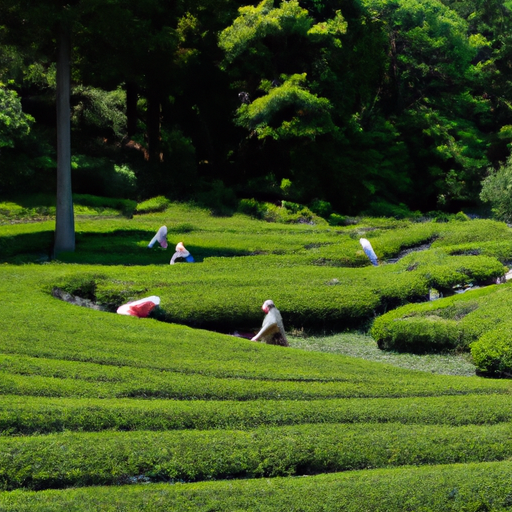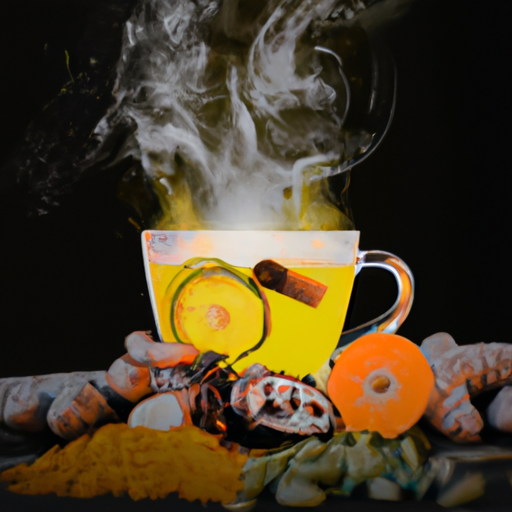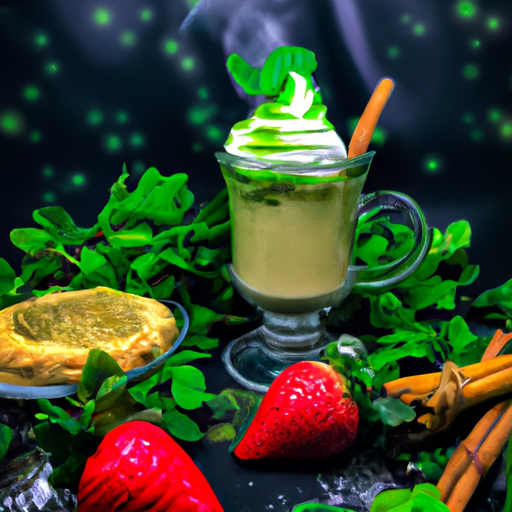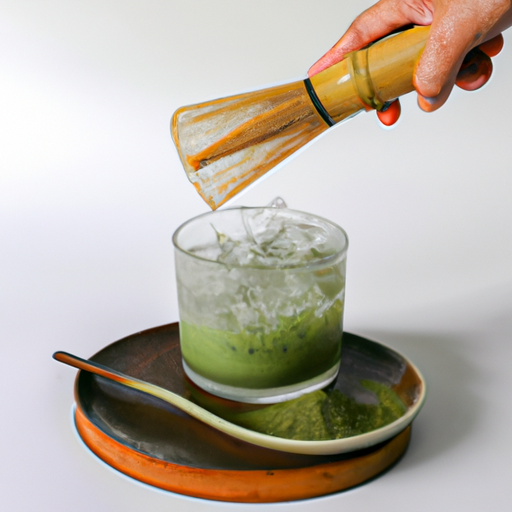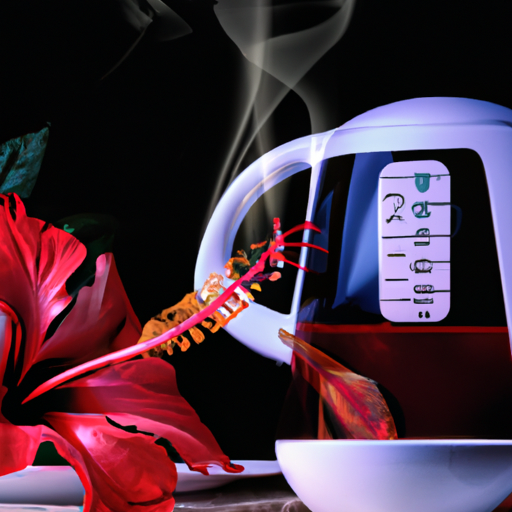I’ve always been captivated by the vivid green hue and unique flavor of matcha. However, where does this cherished tea from Japan originate?
In this article, I’ll be exploring the history, cultivation, and processing of matcha, as well as the health benefits and cultural significance of this unique beverage.
Matcha has a long and rich history that dates back over 800 years. It was first introduced to Japan by a monk named Eisai, who brought the tea seeds from China and planted them in Kyoto. Matcha, meaning ‘powdered tea,’ was initially used by Buddhist monks for its calming and meditative properties.
Over time, matcha became a staple in Japanese tea culture and was eventually incorporated into the traditional Japanese tea ceremony. Today, matcha is widely enjoyed around the world for its unique taste and numerous health benefits.
Key Takeaways
- Matcha was introduced to Japan over 800 years ago by a monk named Eisai and was initially used by Buddhist monks for its calming properties.
- Matcha is grown in Japan and involves shading the tea plants for several weeks before harvest. Farmers use traditional stone mills to grind the leaves into a fine powder.
- Matcha comes in different grades, ranging from ceremonial to culinary, with ceremonial grade being the highest quality and used in traditional tea ceremonies.
- Matcha contains high levels of antioxidants, caffeine for a natural energy boost, and L-theanine, an amino acid that promotes relaxation and reduces stress.
Brief History of Matcha
Matcha has been an integral part of Japanese tea ceremonies for centuries, with its origins dating back to the Tang dynasty in China. The tea was first brought to Japan by Buddhist monks who had traveled to China to study the religion and culture. The monks found the tea to be a useful tool for meditation, and it soon became a staple in the Japanese tea ceremony.
Matcha origins can be traced back to the 9th century in China. The tea was first called ‘powdered tea,’ and it was made by grinding tea leaves into a fine powder. This powder was then whisked into hot water to create a frothy, flavorful tea. The tea quickly became popular among Chinese monks, who used it as a tool for meditation.
The cultural significance of matcha cannot be overstated. The tea is an important part of Japanese culture, and it is often used in religious ceremonies and other important events. Matcha is also considered to be a symbol of hospitality and friendship, and it is often served to guests as a sign of respect.
With such a rich history and cultural significance, it’s no wonder that matcha has become so popular around the world. As matcha has become more popular around the world, many people have become interested in how matcha is grown.
How Matcha is Grown
You may be surprised to learn that the cultivation of matcha involves shading the tea plants for several weeks before harvest. This process ensures that the tea leaves produce more chlorophyll, which gives the matcha its vivid green color. Matcha is typically grown in Japan, where the climate and soil conditions are ideal for producing high-quality tea.
The growing conditions for matcha are carefully monitored to ensure that the tea plants receive the right amount of shade, water, and nutrients. Farmers use a variety of techniques to cultivate matcha, including hand-picking the tea leaves and using traditional stone mills to grind the leaves into a fine powder. These techniques have been passed down through generations of tea farmers and are considered integral to producing the best quality matcha.
Harvesting techniques for matcha vary depending on the variety and the intended use of the tea. Some matcha is harvested by hand while others are harvested using machines. The timing of the harvest can also impact the quality of the tea. Generally, matcha is harvested in the spring when the tea leaves are tender and have a sweeter flavor.
With its unique growing conditions and harvesting techniques, matcha has become a popular beverage around the world. In the next section, we will explore the different varieties of matcha and how they are distinguished from one another.
Varieties of Matcha
If you’re a fan of tea, you’ll be pleased to know that there are various types of matcha available, each with its own unique flavor profile and brewing requirements. Matcha comes in different grades, ranging from ceremonial to culinary.
Ceremonial grade matcha is the highest quality and is used in traditional tea ceremonies. It has a rich, smooth flavor and a vibrant green color.
Culinary grade matcha is less expensive and is often used in cooking and baking. It has a slightly bitter taste and a duller green color.
Another factor that affects matcha’s flavor profile is the region it comes from. Matcha from Uji, Japan is known to have a sweet, grassy flavor, while matcha from Shizuoka, Japan has a more astringent taste. Matcha from Nishio, Japan is considered the most balanced in flavor and is often used in premium blends.
In addition to grades and regions, the age of the tea leaves also influences matcha’s flavor. Younger leaves produce matcha with a more delicate flavor, while older leaves create a stronger, more robust taste. When choosing a matcha, consider these factors to find the flavor profile that best suits your palate.
Matcha’s unique flavor profile is just one of the reasons why it’s become so popular in recent years. But did you know that matcha also offers a wide range of health benefits? Let’s explore the many ways that matcha can boost your health and wellbeing.
The Health Benefits of Matcha
With its numerous health benefits, it’s no wonder why matcha has become a popular drink choice for many.
One of the benefits of matcha is that it contains high levels of antioxidants, which help to protect cells from damage caused by free radicals.
Matcha also contains caffeine, which provides a natural energy boost without the jitters or crash that come with coffee.
Additionally, matcha contains L-theanine, an amino acid that promotes relaxation and reduces stress.
To prepare matcha, one must start by sifting the matcha powder into a bowl to remove any clumps.
Next, hot water is added to the bowl and the mixture is whisked until it becomes frothy.
The traditional Japanese tea ceremony involves a specific set of movements and equipment, but it’s not necessary to follow this exact process to enjoy a delicious cup of matcha.
Transitioning into the subsequent section about the traditional Japanese tea ceremony, it’s important to note that matcha has been an integral part of this ritual for centuries.
From the special utensils used to the specific way in which the tea is served, the Japanese tea ceremony is a beautiful blend of tradition and mindfulness.
Traditional Japanese Tea Ceremony
Experience the beauty and mindfulness of the traditional Japanese tea ceremony, which involves a set of specific movements and equipment to prepare and serve the matcha tea. The ceremony, known as chanoyu or sado, dates back to the 12th century and is a way of connecting with nature and promoting inner peace through the preparation, offering, and reception of tea.
The tea utensils used in the tea ceremony are carefully selected and placed in a specific arrangement, called the tokonoma. The utensils include a tea caddy, tea bowl, tea scoop, whisk, and a cloth. Each utensil has a specific purpose, and the way they are used is part of the etiquette of the ceremony. Following the etiquette is essential to show respect to the host and the tea.
It is interesting to note that the tea used in the ceremony is often high-quality matcha, which is produced in Japan. The matcha is made by grinding the tea leaves into a fine powder, which is then whisked in hot water. The process of producing matcha is intricate and requires great skill, patience, and attention to detail. Understanding the tea ceremony and the production process of matcha helps to appreciate the tea’s taste and significance.
Moving on to the next section, we will explore the different regions in Japan where matcha is produced. The production process and environment play a significant role in the quality and taste of the matcha. So, let’s dive in and learn more about where matcha comes from.
Where Matcha is Produced
You’re about to discover the many regions across Japan that produce matcha, each with their unique environment and production process that contribute to the tea’s exceptional quality and flavor. Matcha is grown in several regions across Japan, with Uji in Kyoto being the most famous. The area is known for its high-quality matcha due to its warm climate, fertile soil, and traditional production methods. Other regions include Nishio in Aichi Prefecture, Shizuoka, and Kagoshima. Each region has its own unique characteristics that contribute to the flavor, color, and aroma of the matcha produced.
Production methods play a crucial role in the quality of matcha. The leaves are shade-grown for a few weeks before harvesting, which increases the chlorophyll content and amino acid levels. The leaves are then carefully hand-picked, steamed, and dried before being ground into a fine powder. The entire process is labor-intensive and requires skilled workers who have been trained in the traditional methods of matcha production. The quality of the matcha can vary depending on the production method used.
Matcha has gained popularity worldwide, and its global distribution has increased in recent years. Japan remains the largest producer of matcha, but other countries such as China, Taiwan, and Korea have started to produce their own versions of the tea. However, Japanese matcha remains the gold standard due to its unique flavor profile and strict production standards.
In the subsequent section, we will delve into the intricate process of how matcha is processed from tea leaves to a fine powder.
How Matcha is Processed
The tea leaves used for matcha are carefully cultivated and harvested before they undergo a meticulous process of steaming, drying, and grinding into a fine, vibrant green powder. The traditional methods of matcha processing are still used today, and require special techniques and tools to ensure the highest quality of matcha.
The tea bushes are shaded for several weeks before the harvest to increase the chlorophyll content in the leaves, which give matcha its vibrant green color and unique flavor profile. The harvesting and processing of matcha differ from other tea types, such as green and black teas. With matcha, the entire leaf is used, rather than just the brewed leaves.
After being steamed and dried, the leaves are deveined and destemmed before being ground into a fine powder. This process creates a smooth and creamy texture, while also preserving the high concentration of nutrients and antioxidants found in the tea leaves. The techniques and tools used in matcha processing have a significant impact on the flavor and quality of the final product.
Some matcha producers use traditional granite stone mills to grind the tea leaves, while others use modern machinery. The method of grinding and the quality of the tea leaves can greatly affect the taste and texture of the matcha. Understanding the intricacies of matcha processing is essential to producing high-quality matcha that is enjoyed by tea enthusiasts around the world.
Matcha’s unique processing techniques and distinct flavor have made it a beloved part of traditional Japanese tea culture. In modern times, matcha has become popular in various culinary and beverage applications, such as matcha lattes and desserts. Its versatility and health benefits have made it a popular choice for those looking for a unique and healthy alternative to traditional teas.
Matcha in Modern Culture
I love how matcha has become a popular ingredient in many cafes and restaurants these days. Matcha lattes, matcha smoothies, and matcha desserts are just a few examples of how this vibrant green tea powder has made its way into our modern culture.
Additionally, matcha-based products such as face masks, body scrubs, and even toothpaste can now be found in beauty stores worldwide. It’s amazing to see how matcha has evolved from a traditional tea ceremony drink to a versatile ingredient in various aspects of our daily lives.
Popularity in cafes and restaurants
Nowadays, matcha has become a staple in cafes and restaurants, with many people enjoying a delicious matcha latte as a trendy alternative to traditional coffee drinks. Matcha’s popularity has skyrocketed in recent years, thanks in part to its appearance in social media as a photogenic and healthy beverage option.
In addition to its visual appeal, matcha’s unique flavor has also been embraced by the food industry, leading to a surge in matcha-flavored treats and desserts. Here are some examples of how matcha is being utilized in the culinary world:
- Matcha pastries, such as croissants and doughnuts, have become a popular breakfast item.
- Matcha ice cream and sorbet have become a mainstream dessert option in many restaurants.
- Matcha powder is being used to flavor everything from smoothies to protein bars.
- Matcha-based cocktails have also made their way onto drink menus in bars and restaurants.
As matcha continues to gain popularity, it’s clear that this versatile ingredient has a bright future in the food and beverage industry.
Matcha-based products
You might be surprised to find matcha in a variety of products, from skincare to energy drinks. Matcha infused cuisine has become a popular trend. Chefs are using the finely ground green tea powder as a key ingredient in dishes such as matcha soba noodles, matcha ice cream, and matcha flavored macarons. Matcha’s unique, slightly bitter flavor pairs well with sweet and savory ingredients, making it a versatile addition to any recipe.
In addition to food, matcha based skincare products have also gained popularity. Matcha contains antioxidants and anti-inflammatory properties, making it an excellent ingredient for skincare products. Matcha masks, serums, and moisturizers have become a staple in many beauty routines. They help to improve skin texture, reduce redness, and protect against environmental stressors.
As the demand for matcha continues to grow, it’s important to consider sustainable and fair trade practices. This ensures that the production of matcha is done in an ethical and environmentally friendly manner.
Sustainability and Fair Trade Practices
Although matcha is often marketed as a trendy and eco-friendly superfood, the reality is that many of the practices used to produce matcha are far from sustainable or fair. As a consumer, it’s important to be aware of the impact your purchasing decisions have on the environment and the people involved in the production process. Here are three key points to consider:
-
Sustainability: Matcha production requires a significant amount of energy and resources, from water to electricity. However, not all matcha producers prioritize sustainability. Look for companies that use renewable energy, implement water conservation measures, and minimize waste in their operations.
-
Ethical sourcing: Matcha is often grown in developing countries where labor laws and workers’ rights aren’t always respected. To ensure that the matcha you buy is ethically sourced, look for certifications such as Fair Trade or Rainforest Alliance. These certifications ensure that workers are paid fairly, have safe working conditions, and receive benefits like healthcare and education.
-
Transparency: Unfortunately, many matcha companies don’t disclose information about their sourcing and production practices. As a consumer, you’ve the right to know where your food comes from and how it was made. Look for companies that’re transparent about their supply chain and’re willing to answer your questions.
Choosing sustainably and ethically sourced matcha isn’t only better for the environment and workers, but it also ensures that you’re getting a high-quality product. By supporting companies that prioritize sustainability and fair trade practices, you can enjoy your matcha with a clear conscience.
Speaking of enjoying matcha, let’s move on to the next section and explore some fun ways to prepare and drink matcha at home.
How to Enjoy Matcha at Home
When it comes to enjoying matcha at home, there are a few key points to keep in mind.
First and foremost, there are a variety of simple and delicious recipes for matcha drinks and desserts that can be easily made in the comfort of your own kitchen.
Additionally, it’s important to choose high-quality matcha and properly prepare it to ensure the best possible taste and health benefits.
As someone who’s been a matcha enthusiast for years, I can confidently say that these tips will help you create the perfect matcha experience at home.
Simple recipes for matcha drinks and desserts
Get ready to indulge in some delicious matcha drinks and desserts that are easy to make at home. Matcha offers a unique flavor profile that can add depth to your favorite drinks and desserts. Here are some simple recipes to get you started:
| Recipe | Ingredients | Directions |
|---|---|---|
| Matcha Latte | 1 tsp matcha powder, 1 cup milk, sweetener of choice | 1) Sift matcha powder into a bowl. 2) Heat milk in a saucepan until hot but not boiling. 3) Pour milk over the matcha powder and whisk until frothy. 4) Add sweetener to taste. |
| Matcha Cheesecake | 1 cup graham cracker crumbs, 1/4 cup melted butter, 2 packages cream cheese, 1/2 cup sugar, 2 eggs, 1 tsp vanilla extract, 2 tbsp matcha powder | 1) Preheat oven to 350°F. 2) Mix graham cracker crumbs and melted butter in a bowl. 3) Press mixture into the bottom of a 9-inch springform pan. 4) Beat cream cheese and sugar in a separate bowl until smooth. 5) Add eggs one at a time, beating after each addition. 6) Mix in vanilla extract and matcha powder. 7) Pour mixture over the graham cracker crust. 8) Bake for 35-40 minutes. |
These recipes are just the beginning of the many ways you can incorporate matcha into your cooking and baking. In addition to drinks and desserts, matcha can also be used in skincare products and infused into savory dishes. Keep reading for tips on choosing and preparing matcha to ensure the best flavor and quality in your recipes.
Tips for choosing and preparing matcha
Now that we’ve learned some simple recipes for matcha drinks and desserts, let’s talk about how to choose and prepare matcha.
When it comes to choosing matcha, it’s important to look for high-quality, ceremonial grade matcha. This type of matcha is made from the youngest leaves of the tea plant and is grown in shaded areas to increase the chlorophyll content. It should have a bright green color, a smooth texture, and a sweet, grassy flavor.
When preparing matcha, it’s important to use the right tools and techniques to ensure the best flavor and texture. First, sift the matcha powder through a fine mesh strainer to remove any clumps. Then, add hot water that is around 175°F to the matcha powder and whisk vigorously in a zigzag motion until it forms a frothy layer on top.
It’s important to use a bamboo whisk or chasen for this process to ensure a smooth and frothy consistency.
With these choosing tips and preparation techniques, you can enjoy a delicious and authentic matcha experience.
Frequently Asked Questions
What is the difference between matcha and regular green tea?
As a tea enthusiast, I can confidently say that the difference between matcha and regular green tea is significant.
Matcha is made from finely ground green tea leaves, which are shade-grown to increase chlorophyll levels and produce a vibrant green color. This unique production method gives matcha a distinct taste that is richer and more robust than regular green tea.
Additionally, matcha contains higher levels of antioxidants and caffeine, making it a healthier alternative to coffee or energy drinks. The benefits of matcha extend beyond just its taste and health benefits, as it also has a calming effect on the mind and body.
When compared to regular green tea, matcha stands out as the superior choice for those seeking a more flavorful and nutritious tea experience.
Can matcha be grown outside of Japan?
Matcha cultivation has traditionally been associated with Japan, as it requires specific conditions and techniques that are difficult to replicate elsewhere.
However, in recent years, matcha production outside Japan has been increasing. Countries like China, Taiwan, and even the United States have started to grow their own matcha, although the quality and taste may differ from the original Japanese matcha.
These countries have experimented with different farming techniques and cultivars to adapt to their local climate and soil conditions. Nonetheless, Japanese matcha remains the most sought-after due to its unique umami flavor and cultural significance.
What is the shelf life of matcha powder?
Well, isn’t it ironic that we’re so concerned about the shelf life of matcha powder when we’re not even sure where it comes from?
But to answer the question at hand, matcha powder can last for up to a year if stored properly. The key to long term storage is to keep it away from moisture, heat, and light.
Once opened, it’s best to transfer the powder to an airtight container and store it in a cool, dry place. If you want to extend its shelf life even further, you can also freeze it. Just be sure to thaw it completely before using it again.
So there you have it, proper storage conditions are crucial for maintaining the quality of your matcha powder.
Can matcha be used in cooking and baking?
Yes, matcha can absolutely be used in cooking and baking! There are so many matcha recipes out there that incorporate this vibrant green powder into everything from cakes and cookies to smoothies and ice cream.
Not only does matcha add a delicious earthy flavor to your dishes, but it also offers a number of health benefits. Matcha is packed with antioxidants, can boost your metabolism, and has been shown to improve brain function and reduce stress.
So not only can you indulge in some delicious matcha treats, but you can also feel good about the added health benefits. Some popular matcha recipes include matcha latte, matcha cheesecake, and matcha pancakes.
So whether you’re looking to satisfy your sweet tooth or simply want to add some extra nutrition to your meals, cooking with matcha is a great option.
Are there any negative side effects of consuming matcha?
There’s an old adage that goes, "too much of a good thing can be bad for you."This is certainly true when it comes to matcha.
While matcha has numerous benefits, including being rich in antioxidants, increasing energy levels, and aiding in weight loss, it’s important to consume it in moderation. Consuming too much matcha can lead to negative side effects such as insomnia, headaches, and an upset stomach.
It’s recommended to consume no more than two cups of matcha per day, and to be mindful of the dosage when adding it to recipes. As with any food or drink, it’s important to enjoy matcha in moderation to reap its benefits without experiencing any negative side effects.
Conclusion
In conclusion, as someone who’s been enjoying matcha for years, I can attest to its unique flavor and health benefits. Learning about the history and cultivation of matcha has only deepened my appreciation for this special tea.
It’s fascinating to think about the centuries-long tradition of the Japanese tea ceremony and how matcha has played a central role in it.
One interesting statistic that caught my attention while researching this article is that Japan produces 80% of the world’s matcha. This underscores the importance of fair trade and sustainability practices in the matcha industry.
As matcha continues to gain popularity worldwide, it’s essential to support ethical and environmentally-friendly production methods. Whether you enjoy matcha in a traditional tea ceremony or in a latte at your local coffee shop, taking the time to learn about its origins and production can enhance your appreciation of this remarkable tea.

